E-Business Essay: Changes in Trading Patterns and Marketplace Models
VerifiedAdded on 2022/09/18
|7
|1784
|23
Essay
AI Summary
This essay explores the evolving landscape of e-business, focusing on how it has reshaped trading patterns and marketplace models. The paper begins by defining e-business and differentiating it from traditional business approaches. It then delves into the changing dynamics of consumer and business trading patterns, analyzing industry structures, industry structural analysis/industry dynamics, industry value chains, and firm value chains. The role of social commerce business models and consumers' social commerce shopping behavior are also examined, providing insights into how businesses adapt to the digital era. Furthermore, the essay critically analyzes the Technology Acceptance Model (TAM) to understand how users adopt and utilize technology. The analysis encompasses a range of topics from industry structure, value chains and consumer shopping behavior to the TAM theoretical framework. In conclusion, the essay highlights the significant role of e-commerce in modern business, emphasizing the importance of adapting to technological advancements. The paper explores the benefits of online services for both businesses and consumers, and the report also explains the role of social commerce in gathering more customers. Finally, the differences between e-business and traditional business are stated, and the changing patterns of business and consumer traditions are evaluated.
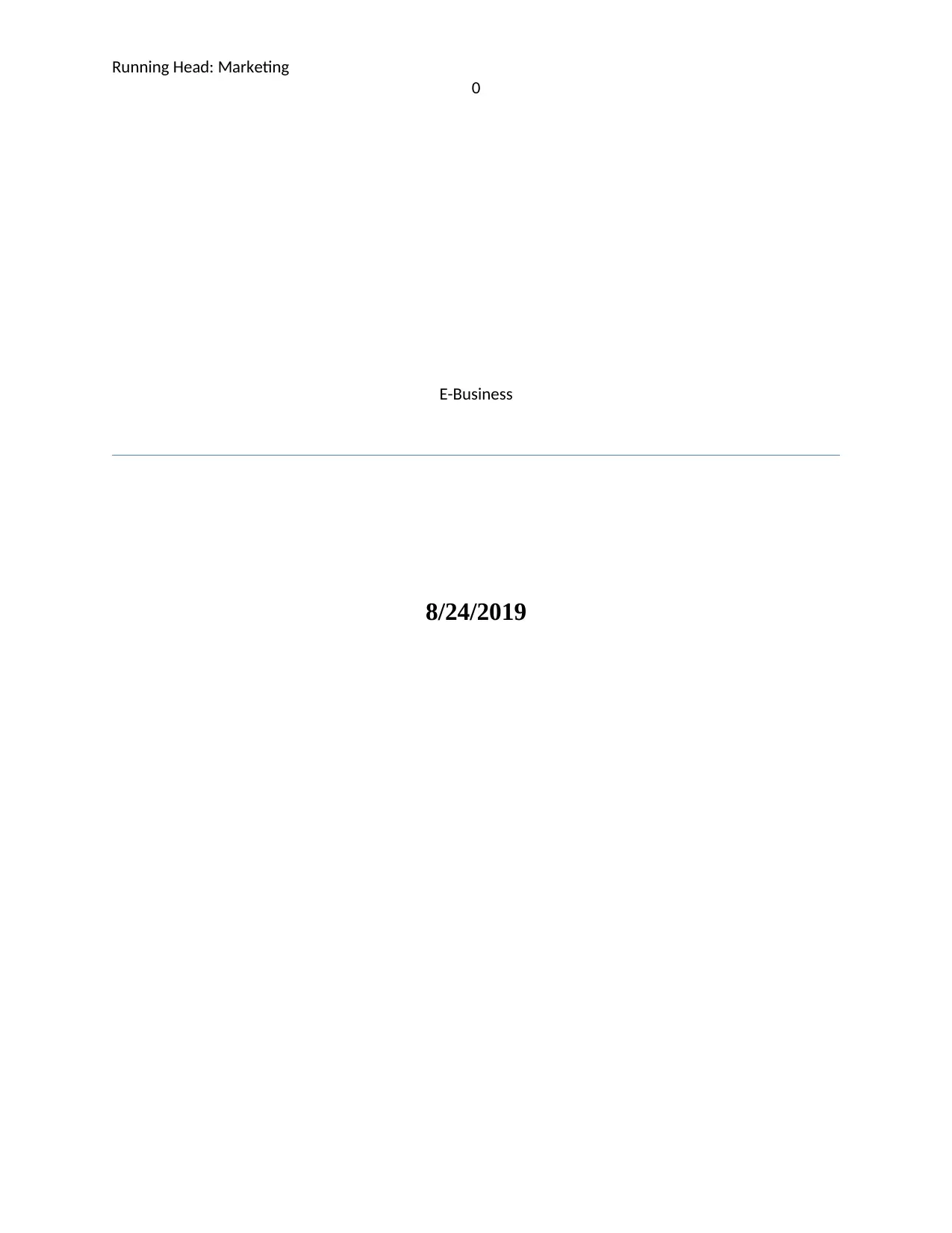
Running Head: Marketing
0
E-Business
8/24/2019
0
E-Business
8/24/2019
Paraphrase This Document
Need a fresh take? Get an instant paraphrase of this document with our AI Paraphraser
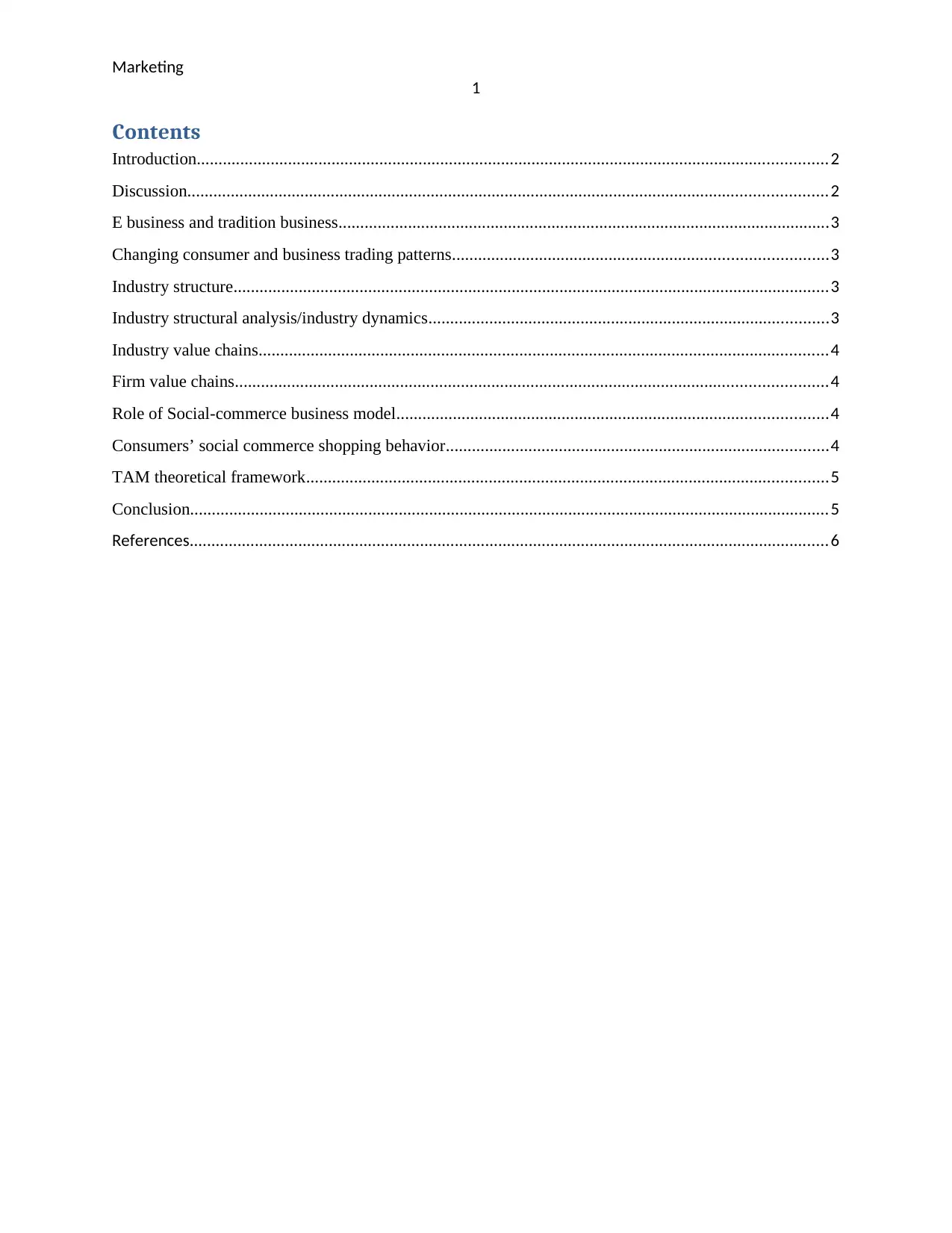
Marketing
1
Contents
Introduction.................................................................................................................................................2
Discussion...................................................................................................................................................2
E business and tradition business.................................................................................................................3
Changing consumer and business trading patterns......................................................................................3
Industry structure.........................................................................................................................................3
Industry structural analysis/industry dynamics............................................................................................3
Industry value chains...................................................................................................................................4
Firm value chains........................................................................................................................................4
Role of Social-commerce business model...................................................................................................4
Consumers’ social commerce shopping behavior........................................................................................4
TAM theoretical framework........................................................................................................................5
Conclusion...................................................................................................................................................5
References...................................................................................................................................................6
1
Contents
Introduction.................................................................................................................................................2
Discussion...................................................................................................................................................2
E business and tradition business.................................................................................................................3
Changing consumer and business trading patterns......................................................................................3
Industry structure.........................................................................................................................................3
Industry structural analysis/industry dynamics............................................................................................3
Industry value chains...................................................................................................................................4
Firm value chains........................................................................................................................................4
Role of Social-commerce business model...................................................................................................4
Consumers’ social commerce shopping behavior........................................................................................4
TAM theoretical framework........................................................................................................................5
Conclusion...................................................................................................................................................5
References...................................................................................................................................................6
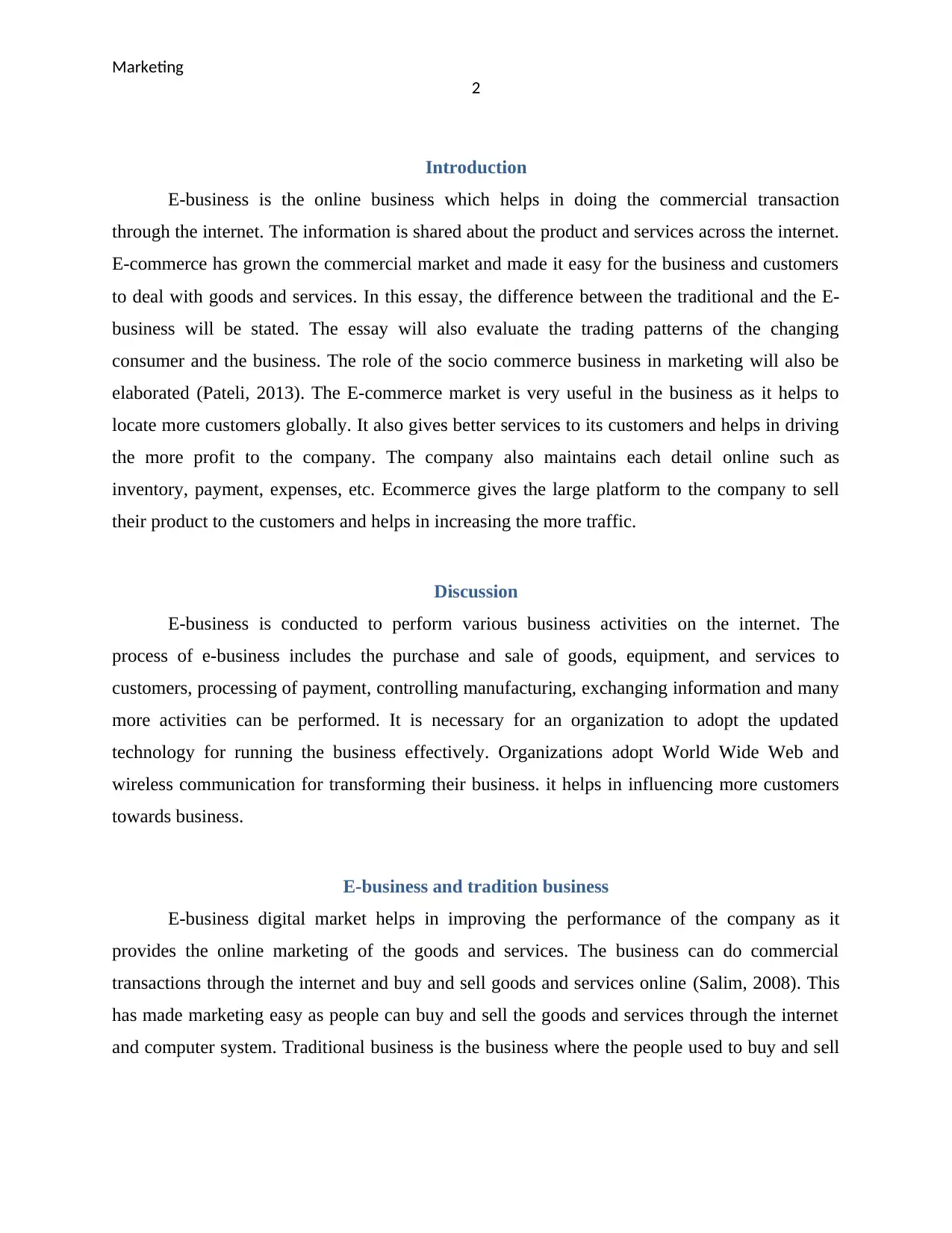
Marketing
2
Introduction
E-business is the online business which helps in doing the commercial transaction
through the internet. The information is shared about the product and services across the internet.
E-commerce has grown the commercial market and made it easy for the business and customers
to deal with goods and services. In this essay, the difference between the traditional and the E-
business will be stated. The essay will also evaluate the trading patterns of the changing
consumer and the business. The role of the socio commerce business in marketing will also be
elaborated (Pateli, 2013). The E-commerce market is very useful in the business as it helps to
locate more customers globally. It also gives better services to its customers and helps in driving
the more profit to the company. The company also maintains each detail online such as
inventory, payment, expenses, etc. Ecommerce gives the large platform to the company to sell
their product to the customers and helps in increasing the more traffic.
Discussion
E-business is conducted to perform various business activities on the internet. The
process of e-business includes the purchase and sale of goods, equipment, and services to
customers, processing of payment, controlling manufacturing, exchanging information and many
more activities can be performed. It is necessary for an organization to adopt the updated
technology for running the business effectively. Organizations adopt World Wide Web and
wireless communication for transforming their business. it helps in influencing more customers
towards business.
E-business and tradition business
E-business digital market helps in improving the performance of the company as it
provides the online marketing of the goods and services. The business can do commercial
transactions through the internet and buy and sell goods and services online (Salim, 2008). This
has made marketing easy as people can buy and sell the goods and services through the internet
and computer system. Traditional business is the business where the people used to buy and sell
2
Introduction
E-business is the online business which helps in doing the commercial transaction
through the internet. The information is shared about the product and services across the internet.
E-commerce has grown the commercial market and made it easy for the business and customers
to deal with goods and services. In this essay, the difference between the traditional and the E-
business will be stated. The essay will also evaluate the trading patterns of the changing
consumer and the business. The role of the socio commerce business in marketing will also be
elaborated (Pateli, 2013). The E-commerce market is very useful in the business as it helps to
locate more customers globally. It also gives better services to its customers and helps in driving
the more profit to the company. The company also maintains each detail online such as
inventory, payment, expenses, etc. Ecommerce gives the large platform to the company to sell
their product to the customers and helps in increasing the more traffic.
Discussion
E-business is conducted to perform various business activities on the internet. The
process of e-business includes the purchase and sale of goods, equipment, and services to
customers, processing of payment, controlling manufacturing, exchanging information and many
more activities can be performed. It is necessary for an organization to adopt the updated
technology for running the business effectively. Organizations adopt World Wide Web and
wireless communication for transforming their business. it helps in influencing more customers
towards business.
E-business and tradition business
E-business digital market helps in improving the performance of the company as it
provides the online marketing of the goods and services. The business can do commercial
transactions through the internet and buy and sell goods and services online (Salim, 2008). This
has made marketing easy as people can buy and sell the goods and services through the internet
and computer system. Traditional business is the business where the people used to buy and sell
⊘ This is a preview!⊘
Do you want full access?
Subscribe today to unlock all pages.

Trusted by 1+ million students worldwide
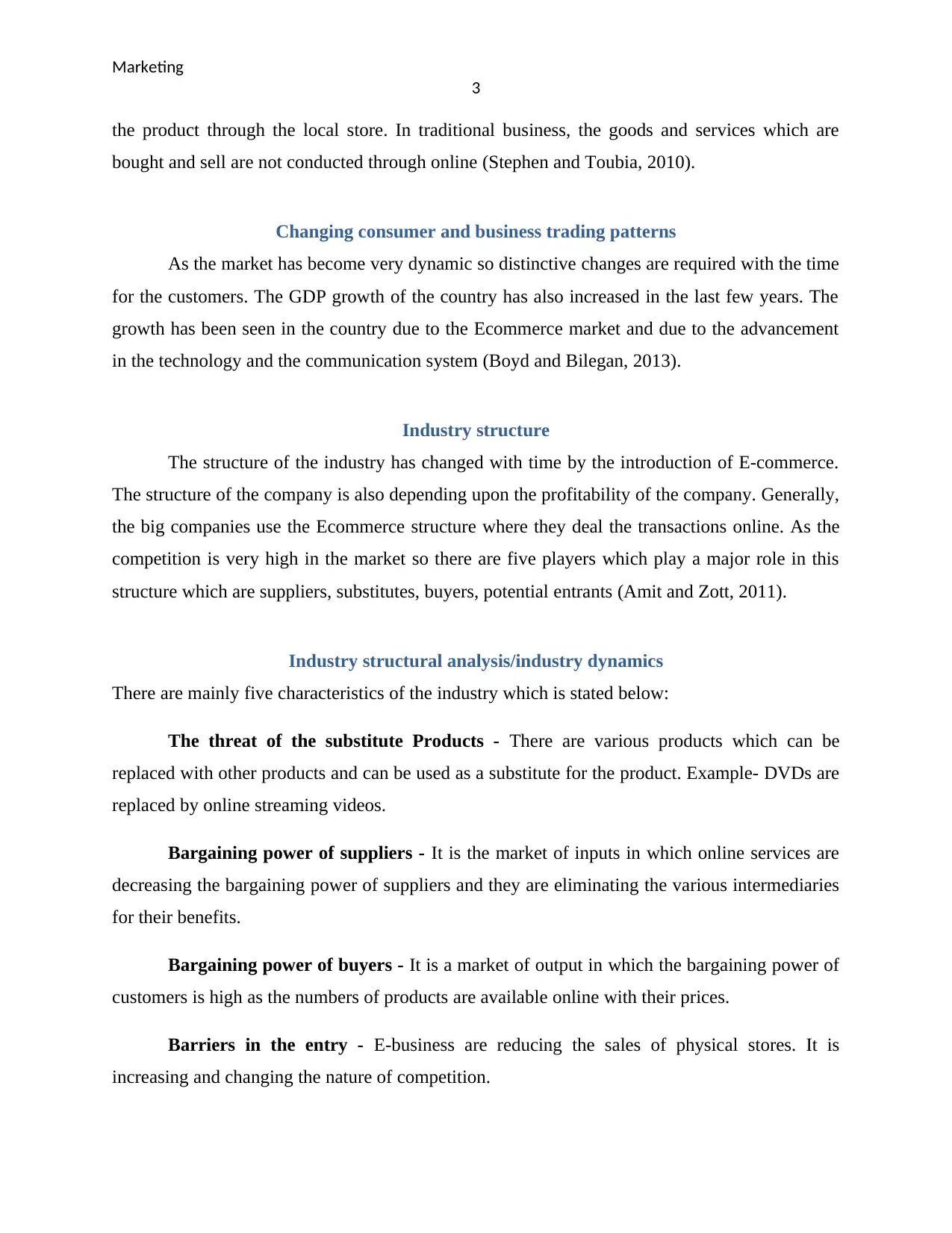
Marketing
3
the product through the local store. In traditional business, the goods and services which are
bought and sell are not conducted through online (Stephen and Toubia, 2010).
Changing consumer and business trading patterns
As the market has become very dynamic so distinctive changes are required with the time
for the customers. The GDP growth of the country has also increased in the last few years. The
growth has been seen in the country due to the Ecommerce market and due to the advancement
in the technology and the communication system (Boyd and Bilegan, 2013).
Industry structure
The structure of the industry has changed with time by the introduction of E-commerce.
The structure of the company is also depending upon the profitability of the company. Generally,
the big companies use the Ecommerce structure where they deal the transactions online. As the
competition is very high in the market so there are five players which play a major role in this
structure which are suppliers, substitutes, buyers, potential entrants (Amit and Zott, 2011).
Industry structural analysis/industry dynamics
There are mainly five characteristics of the industry which is stated below:
The threat of the substitute Products - There are various products which can be
replaced with other products and can be used as a substitute for the product. Example- DVDs are
replaced by online streaming videos.
Bargaining power of suppliers - It is the market of inputs in which online services are
decreasing the bargaining power of suppliers and they are eliminating the various intermediaries
for their benefits.
Bargaining power of buyers - It is a market of output in which the bargaining power of
customers is high as the numbers of products are available online with their prices.
Barriers in the entry - E-business are reducing the sales of physical stores. It is
increasing and changing the nature of competition.
3
the product through the local store. In traditional business, the goods and services which are
bought and sell are not conducted through online (Stephen and Toubia, 2010).
Changing consumer and business trading patterns
As the market has become very dynamic so distinctive changes are required with the time
for the customers. The GDP growth of the country has also increased in the last few years. The
growth has been seen in the country due to the Ecommerce market and due to the advancement
in the technology and the communication system (Boyd and Bilegan, 2013).
Industry structure
The structure of the industry has changed with time by the introduction of E-commerce.
The structure of the company is also depending upon the profitability of the company. Generally,
the big companies use the Ecommerce structure where they deal the transactions online. As the
competition is very high in the market so there are five players which play a major role in this
structure which are suppliers, substitutes, buyers, potential entrants (Amit and Zott, 2011).
Industry structural analysis/industry dynamics
There are mainly five characteristics of the industry which is stated below:
The threat of the substitute Products - There are various products which can be
replaced with other products and can be used as a substitute for the product. Example- DVDs are
replaced by online streaming videos.
Bargaining power of suppliers - It is the market of inputs in which online services are
decreasing the bargaining power of suppliers and they are eliminating the various intermediaries
for their benefits.
Bargaining power of buyers - It is a market of output in which the bargaining power of
customers is high as the numbers of products are available online with their prices.
Barriers in the entry - E-business are reducing the sales of physical stores. It is
increasing and changing the nature of competition.
Paraphrase This Document
Need a fresh take? Get an instant paraphrase of this document with our AI Paraphraser
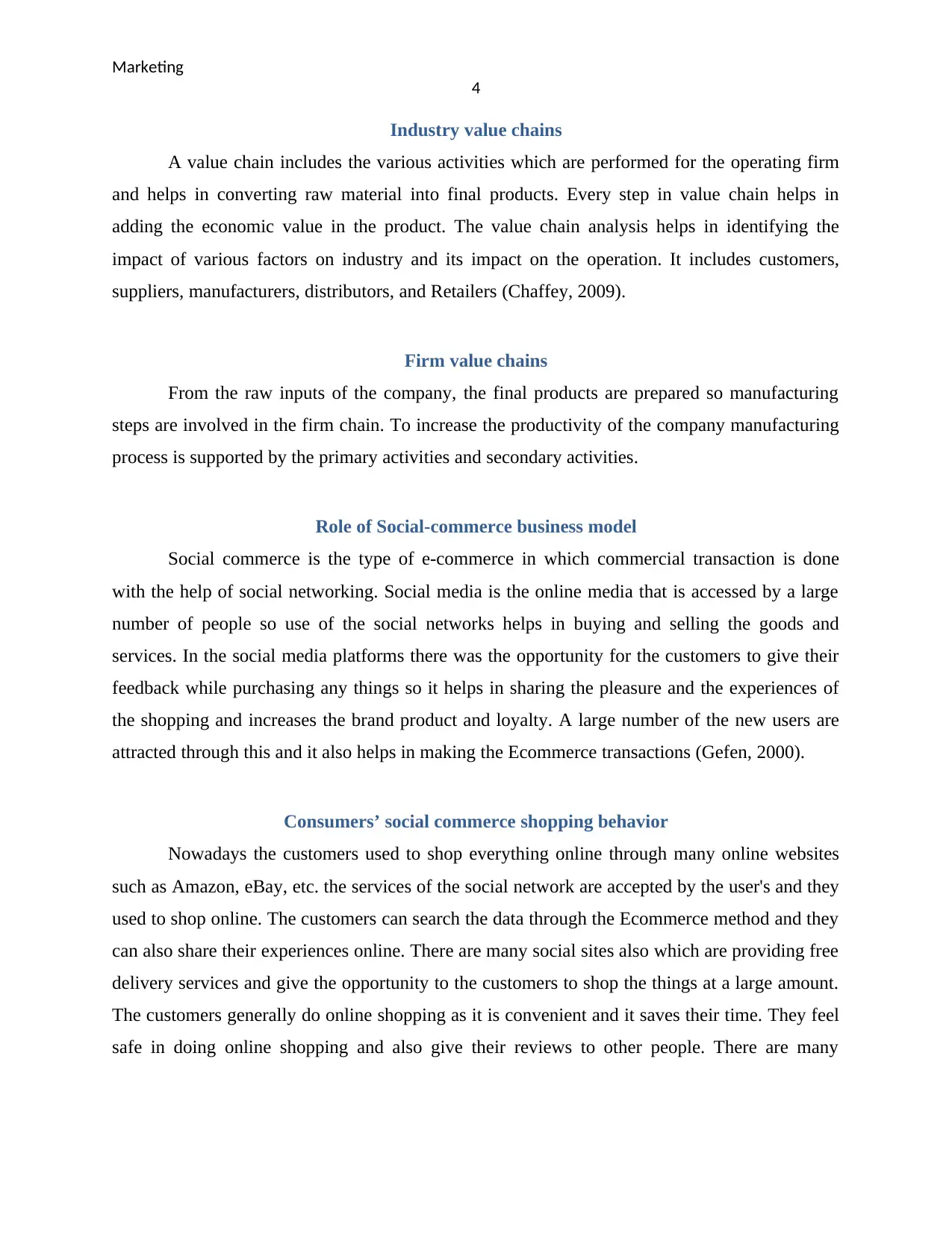
Marketing
4
Industry value chains
A value chain includes the various activities which are performed for the operating firm
and helps in converting raw material into final products. Every step in value chain helps in
adding the economic value in the product. The value chain analysis helps in identifying the
impact of various factors on industry and its impact on the operation. It includes customers,
suppliers, manufacturers, distributors, and Retailers (Chaffey, 2009).
Firm value chains
From the raw inputs of the company, the final products are prepared so manufacturing
steps are involved in the firm chain. To increase the productivity of the company manufacturing
process is supported by the primary activities and secondary activities.
Role of Social-commerce business model
Social commerce is the type of e-commerce in which commercial transaction is done
with the help of social networking. Social media is the online media that is accessed by a large
number of people so use of the social networks helps in buying and selling the goods and
services. In the social media platforms there was the opportunity for the customers to give their
feedback while purchasing any things so it helps in sharing the pleasure and the experiences of
the shopping and increases the brand product and loyalty. A large number of the new users are
attracted through this and it also helps in making the Ecommerce transactions (Gefen, 2000).
Consumers’ social commerce shopping behavior
Nowadays the customers used to shop everything online through many online websites
such as Amazon, eBay, etc. the services of the social network are accepted by the user's and they
used to shop online. The customers can search the data through the Ecommerce method and they
can also share their experiences online. There are many social sites also which are providing free
delivery services and give the opportunity to the customers to shop the things at a large amount.
The customers generally do online shopping as it is convenient and it saves their time. They feel
safe in doing online shopping and also give their reviews to other people. There are many
4
Industry value chains
A value chain includes the various activities which are performed for the operating firm
and helps in converting raw material into final products. Every step in value chain helps in
adding the economic value in the product. The value chain analysis helps in identifying the
impact of various factors on industry and its impact on the operation. It includes customers,
suppliers, manufacturers, distributors, and Retailers (Chaffey, 2009).
Firm value chains
From the raw inputs of the company, the final products are prepared so manufacturing
steps are involved in the firm chain. To increase the productivity of the company manufacturing
process is supported by the primary activities and secondary activities.
Role of Social-commerce business model
Social commerce is the type of e-commerce in which commercial transaction is done
with the help of social networking. Social media is the online media that is accessed by a large
number of people so use of the social networks helps in buying and selling the goods and
services. In the social media platforms there was the opportunity for the customers to give their
feedback while purchasing any things so it helps in sharing the pleasure and the experiences of
the shopping and increases the brand product and loyalty. A large number of the new users are
attracted through this and it also helps in making the Ecommerce transactions (Gefen, 2000).
Consumers’ social commerce shopping behavior
Nowadays the customers used to shop everything online through many online websites
such as Amazon, eBay, etc. the services of the social network are accepted by the user's and they
used to shop online. The customers can search the data through the Ecommerce method and they
can also share their experiences online. There are many social sites also which are providing free
delivery services and give the opportunity to the customers to shop the things at a large amount.
The customers generally do online shopping as it is convenient and it saves their time. They feel
safe in doing online shopping and also give their reviews to other people. There are many

Marketing
5
websites which provide all the useful material tone store only such as Amazon, people can buy
food, clothing, electronic and other useful material for that sites at any time (Barnes, 2012).
TAM theoretical framework
TAM is based on two things which are practical effects and theoretical assumptions. The
technology acceptance model basically designs to accept technology and its use. How and, when
people should use technology, is described in the theoretical design. It includes the three
constructs which are perceived usefulness, perceived ease of use and user attitude towards usage
(Abdalla, 2007).
Perceived usefulness- It includes the use of the system helps in increasing job
performance. A teacher can use the online system for teaching purposes will help in enhancing
the skills of students.
Perceived ease of use- It includes the use of an online system as it is easy to access the
hardware and software. It is designed in a way to operate easily without any training.
Attitude towards Usage- It is important for accepting technology. It is necessary to
accept the technology and use it in an efficient way and follow the procedure.
Conclusion
In order to conclude the report, it is analyzed that E-commerce plays a significant role in
business. It is convenient for consumers also to shop online. Businesses are adopting online
services for attracting customers and expanding their business globally. It is necessary for
companies to adopt updated technology to compete in the market. The various operating systems
like mobile phones are having IOS, Android and windows which helps in accessing the websites
easily and helps in providing the information to consumers. Online services are taking place in
the market and people are accepting the online service is a great way as it is convenient for them
in many cases. In this report the role of social commerce has explained which helps in gathering
the more customers and the theoretical framework of the TAM is also applied. The
differentiation of the e-business and the traditional business is stated in this report and changing
business and consumers tradition patterns is also evaluated.
5
websites which provide all the useful material tone store only such as Amazon, people can buy
food, clothing, electronic and other useful material for that sites at any time (Barnes, 2012).
TAM theoretical framework
TAM is based on two things which are practical effects and theoretical assumptions. The
technology acceptance model basically designs to accept technology and its use. How and, when
people should use technology, is described in the theoretical design. It includes the three
constructs which are perceived usefulness, perceived ease of use and user attitude towards usage
(Abdalla, 2007).
Perceived usefulness- It includes the use of the system helps in increasing job
performance. A teacher can use the online system for teaching purposes will help in enhancing
the skills of students.
Perceived ease of use- It includes the use of an online system as it is easy to access the
hardware and software. It is designed in a way to operate easily without any training.
Attitude towards Usage- It is important for accepting technology. It is necessary to
accept the technology and use it in an efficient way and follow the procedure.
Conclusion
In order to conclude the report, it is analyzed that E-commerce plays a significant role in
business. It is convenient for consumers also to shop online. Businesses are adopting online
services for attracting customers and expanding their business globally. It is necessary for
companies to adopt updated technology to compete in the market. The various operating systems
like mobile phones are having IOS, Android and windows which helps in accessing the websites
easily and helps in providing the information to consumers. Online services are taking place in
the market and people are accepting the online service is a great way as it is convenient for them
in many cases. In this report the role of social commerce has explained which helps in gathering
the more customers and the theoretical framework of the TAM is also applied. The
differentiation of the e-business and the traditional business is stated in this report and changing
business and consumers tradition patterns is also evaluated.
⊘ This is a preview!⊘
Do you want full access?
Subscribe today to unlock all pages.

Trusted by 1+ million students worldwide
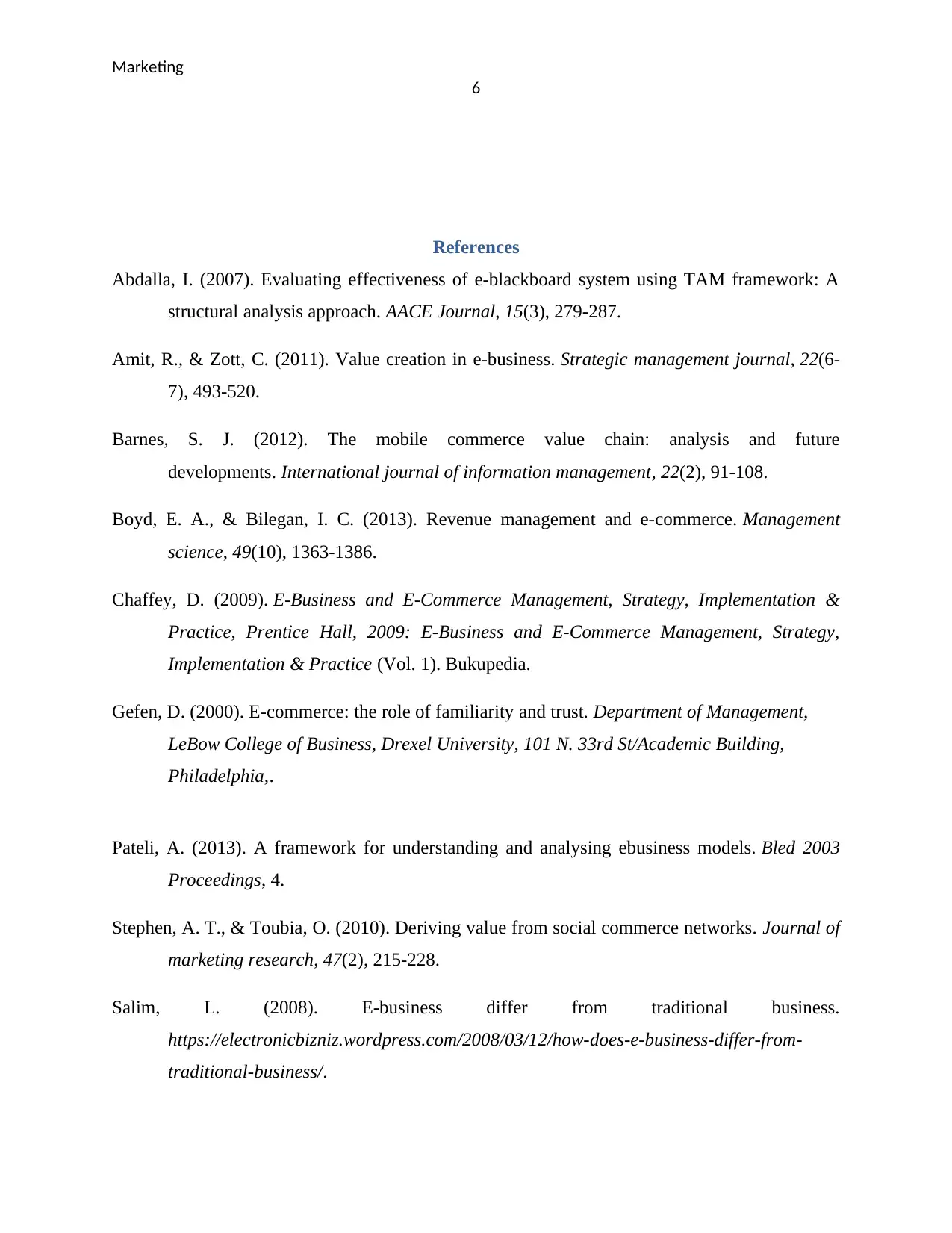
Marketing
6
References
Abdalla, I. (2007). Evaluating effectiveness of e-blackboard system using TAM framework: A
structural analysis approach. AACE Journal, 15(3), 279-287.
Amit, R., & Zott, C. (2011). Value creation in e‐business. Strategic management journal, 22(6‐
7), 493-520.
Barnes, S. J. (2012). The mobile commerce value chain: analysis and future
developments. International journal of information management, 22(2), 91-108.
Boyd, E. A., & Bilegan, I. C. (2013). Revenue management and e-commerce. Management
science, 49(10), 1363-1386.
Chaffey, D. (2009). E-Business and E-Commerce Management, Strategy, Implementation &
Practice, Prentice Hall, 2009: E-Business and E-Commerce Management, Strategy,
Implementation & Practice (Vol. 1). Bukupedia.
Gefen, D. (2000). E-commerce: the role of familiarity and trust. Department of Management,
LeBow College of Business, Drexel University, 101 N. 33rd St/Academic Building,
Philadelphia,.
Pateli, A. (2013). A framework for understanding and analysing ebusiness models. Bled 2003
Proceedings, 4.
Stephen, A. T., & Toubia, O. (2010). Deriving value from social commerce networks. Journal of
marketing research, 47(2), 215-228.
Salim, L. (2008). E-business differ from traditional business.
https://electronicbizniz.wordpress.com/2008/03/12/how-does-e-business-differ-from-
traditional-business/.
6
References
Abdalla, I. (2007). Evaluating effectiveness of e-blackboard system using TAM framework: A
structural analysis approach. AACE Journal, 15(3), 279-287.
Amit, R., & Zott, C. (2011). Value creation in e‐business. Strategic management journal, 22(6‐
7), 493-520.
Barnes, S. J. (2012). The mobile commerce value chain: analysis and future
developments. International journal of information management, 22(2), 91-108.
Boyd, E. A., & Bilegan, I. C. (2013). Revenue management and e-commerce. Management
science, 49(10), 1363-1386.
Chaffey, D. (2009). E-Business and E-Commerce Management, Strategy, Implementation &
Practice, Prentice Hall, 2009: E-Business and E-Commerce Management, Strategy,
Implementation & Practice (Vol. 1). Bukupedia.
Gefen, D. (2000). E-commerce: the role of familiarity and trust. Department of Management,
LeBow College of Business, Drexel University, 101 N. 33rd St/Academic Building,
Philadelphia,.
Pateli, A. (2013). A framework for understanding and analysing ebusiness models. Bled 2003
Proceedings, 4.
Stephen, A. T., & Toubia, O. (2010). Deriving value from social commerce networks. Journal of
marketing research, 47(2), 215-228.
Salim, L. (2008). E-business differ from traditional business.
https://electronicbizniz.wordpress.com/2008/03/12/how-does-e-business-differ-from-
traditional-business/.
1 out of 7
Related Documents
Your All-in-One AI-Powered Toolkit for Academic Success.
+13062052269
info@desklib.com
Available 24*7 on WhatsApp / Email
![[object Object]](/_next/static/media/star-bottom.7253800d.svg)
Unlock your academic potential
Copyright © 2020–2025 A2Z Services. All Rights Reserved. Developed and managed by ZUCOL.




